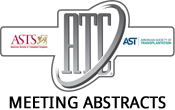2022 American Transplant Congress
Characterization of Kidney Allograft Pathology Using the Histomap Gene Expression Profile (GEP) and Formalin Fixed Paraffin Embedded (FFPE) Tissue
*Purpose: The new Banff Human Organ Transplant (B-HOT) gene panel assessed on nCounter system has been created through a collaboration between NanoString and the Banff…2022 American Transplant Congress
Defining New Arterial and Arteriolar Lesions Accompanying Transplant Glomerulopathy: Potential Additions to the Histologic Assessment of ABMR
*Purpose: Transplant glomerulopathy (TG) results from chronic endothelial injury most commonly related to ABMR. Surprisingly, except for PTC, the relation between TG and other vascular…2022 American Transplant Congress
Regulatory T and B Cell Responses Are Equally Compromised During Antibody-Mediated Rejection of Kidney Allografts
*Purpose: Although considerable advances have been made in understanding the cellular effector mechanisms responsible for donor-specific antibody (DSA) generation leading to antibody-mediated rejection (ABMR), the…2022 American Transplant Congress
Clinical Validation of Automated Urinary Chemokine Assays for Non-Invasive Detection of Kidney Transplant Rejection: A Large Prospective Cohort Study
*Purpose: Non-invasive diagnostic markers for kidney transplant rejection can provide useful information but often do not reach the clinical implementation stage. The chemokines CXCL9 and…2022 American Transplant Congress
Modern Medicine Needs Modern Technology Tools
Ochsner Foundation Hospital, New Orleans, LA
*Purpose: Dd-cfDNA has been used as a non-invasive biomarker for allograft injury and has been shown to detect subclinical rejection with higher predictive power compare…2022 American Transplant Congress
Can dd-cf DNA Eliminate Unnecessary Biopsies? The Answer is Yes!
University Hospitals Cleveland Medical Center, Cleveland, OH
*Purpose: Historically our center has been one that routinely performs biopsies. We perform them pre-perfusion, for slowly recovering allografts between day 10-14, and routinely at…2022 American Transplant Congress
Optimizing Kidney Transplant Immunosuppression Using a Phenotypic Personalized Dosing Model
*Purpose: Immunosuppression is essential for preventing rejection and promoting long-term graft survival following solid organ transplantation; it also places patients at risk for infection and…2022 American Transplant Congress
Baseline Levels and Early Post-Transplant Kinetics of Donor-Derived Cell-Free DNA Following Liver Transplantation
*Purpose: Non-invasive biomarkers in liver transplant (LT) are needed to improve detection of allograft injury in routine surveillance and during immunosuppression modulation, prior to the…2022 American Transplant Congress
Early Detection of Acute Rejection by Urine QSant is Not Confounded by Post-Transplant Time
1Erasmus MC, Rotterdam, Netherlands, 2NephroSant, Brisbane, CA
*Purpose: We explore the viability of urinary biomarker-based monitoring for rejection in early days following renal transplantation.*Methods: Patients are from the Erasmus MC and received…2022 American Transplant Congress
BiomarkeR Initiative to Advance Transplantation OutcomEs in Children (BRITE-c) Analysis
*Purpose: Recent studies indicate that 25-36% of clinically stable pediatric renal transplant recipients will have subclinical rejection detected on surveillance biopsy. These findings highlight a…
- « Previous Page
- 1
- 2
- 3
- 4
- 5
- …
- 172
- Next Page »
